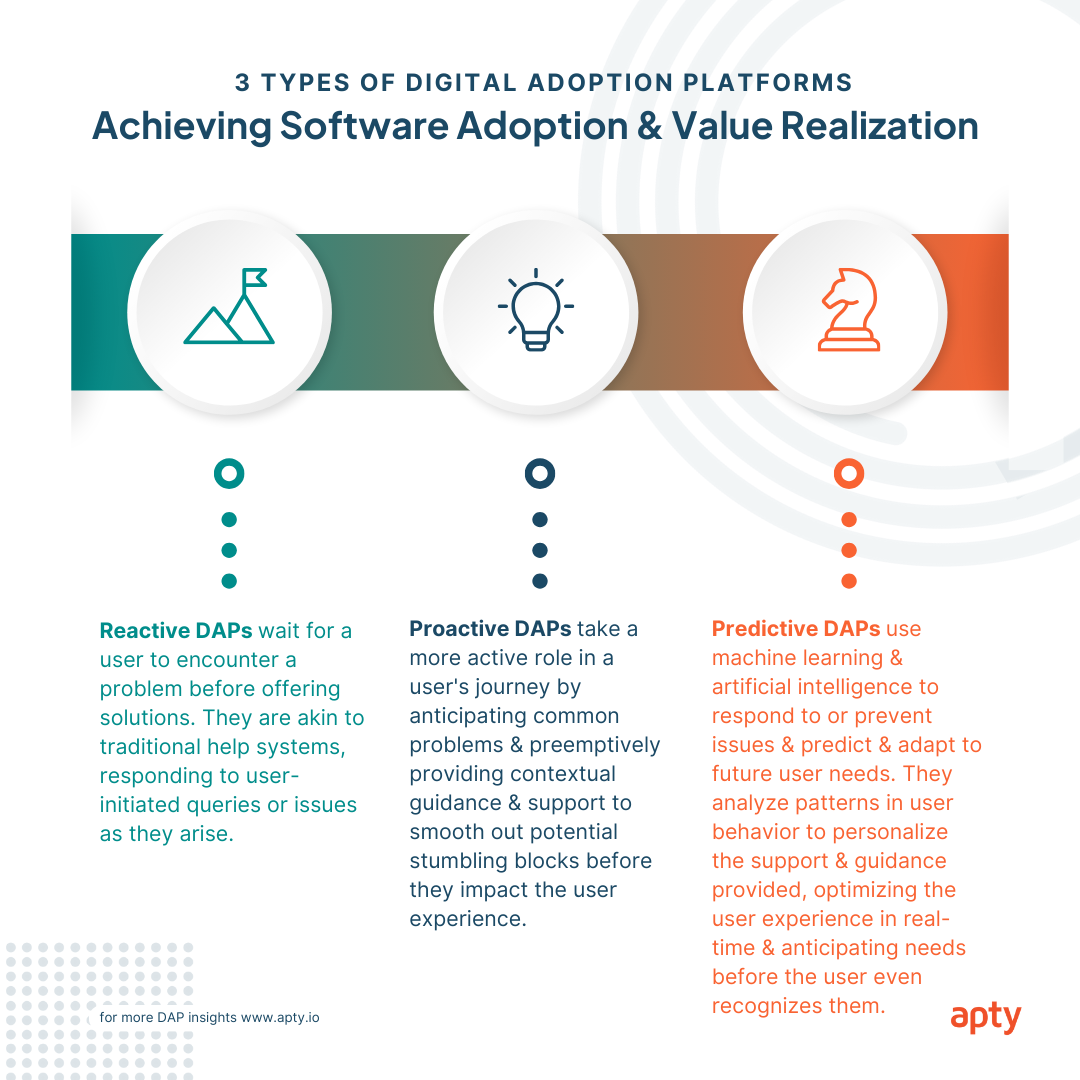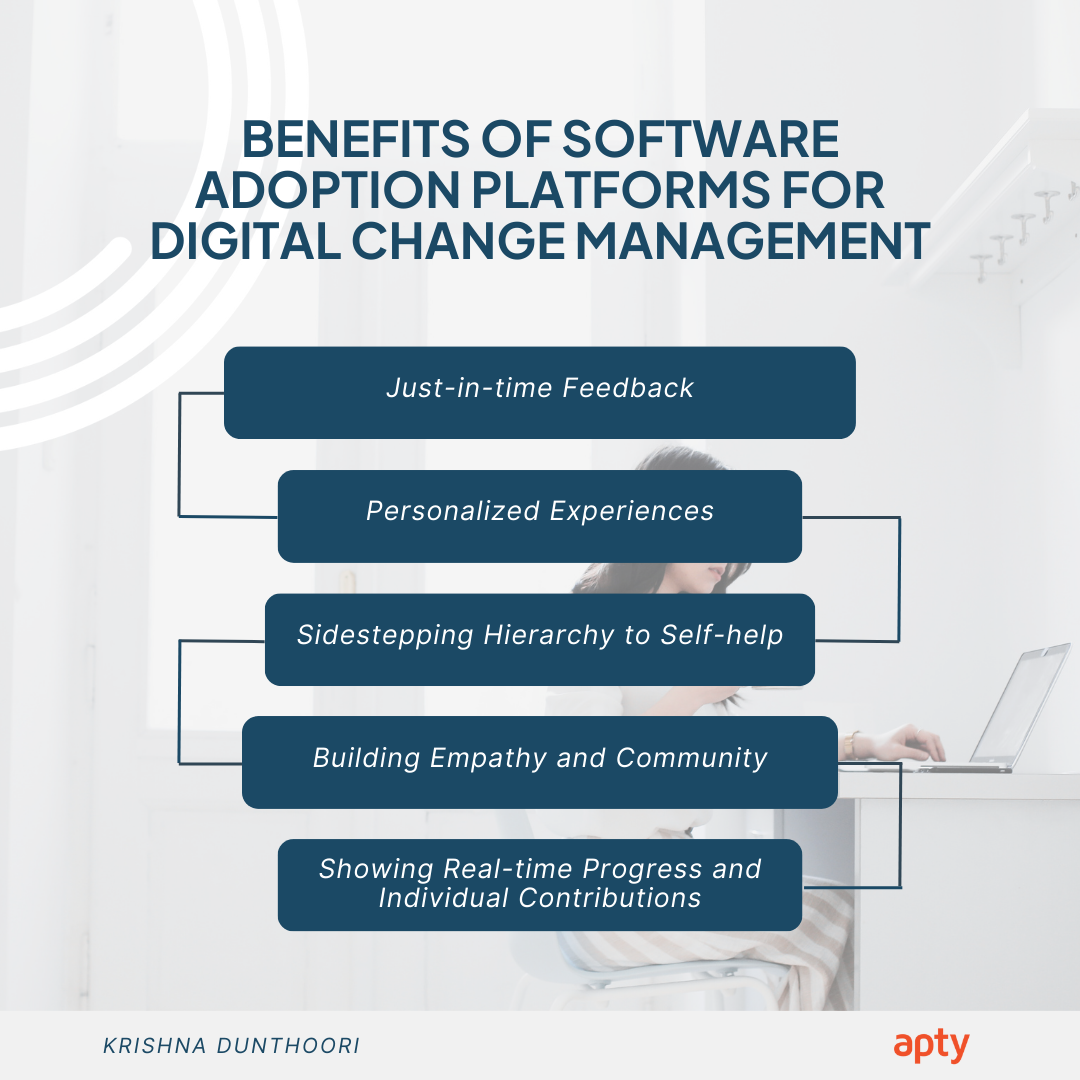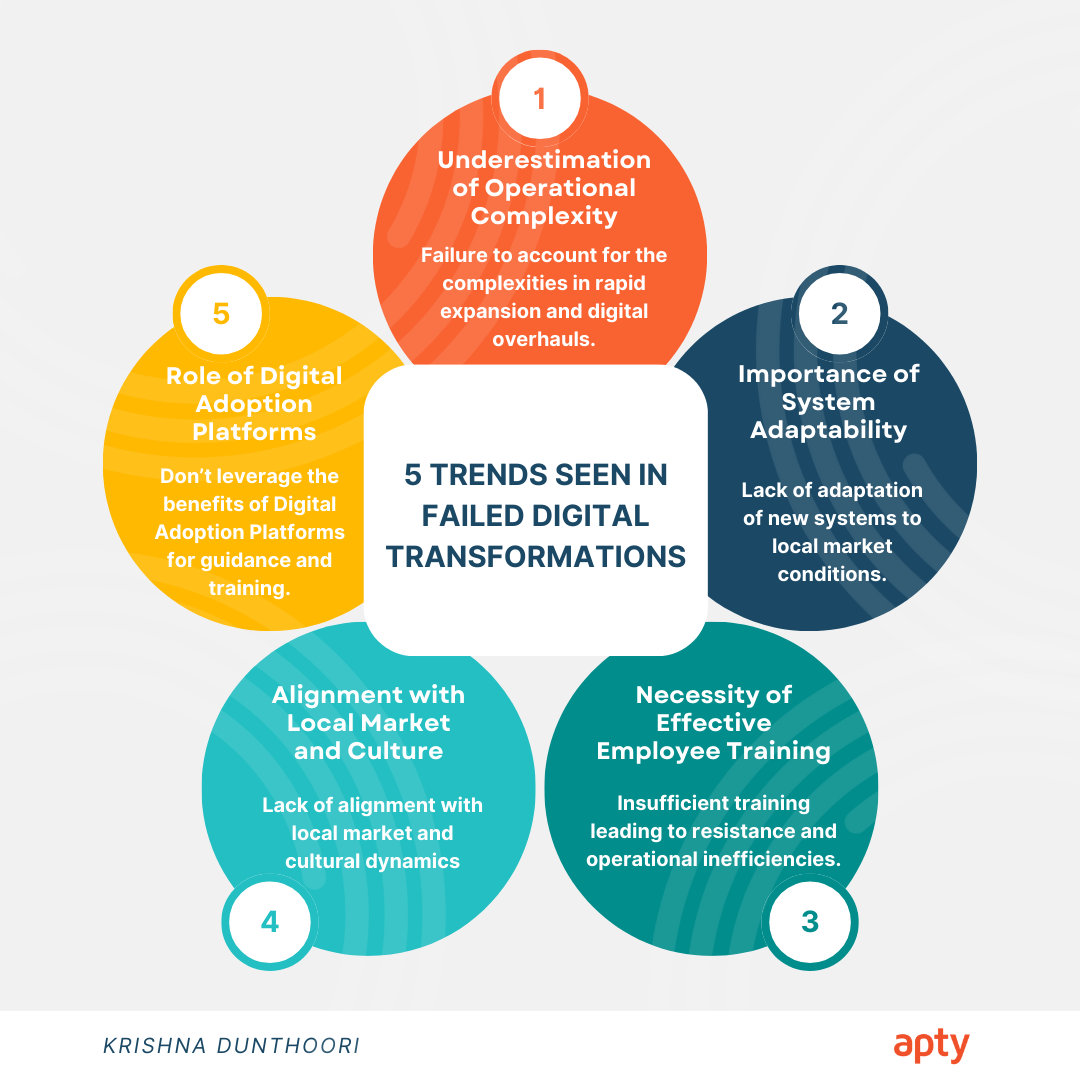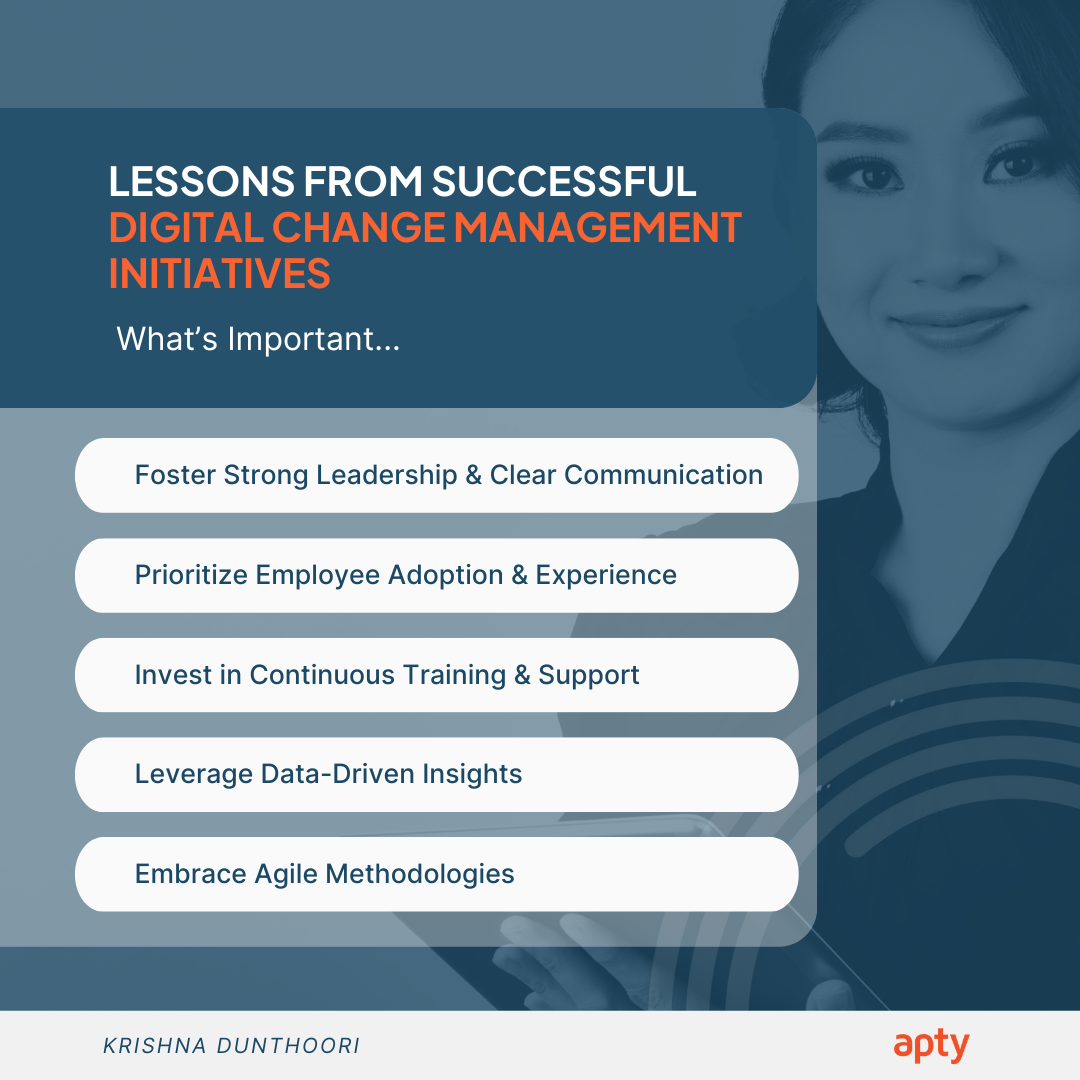What is a Digital Adoption Platform (DAP)?
The world is evolving rapidly, and organizations must constantly embrace cutting-edge technologies to stay competitive and agile. Organizations across all industries continuously seek innovative solutions to enhance operational efficiency, employee productivity, and customer satisfaction. But once implemented, do they see the value promised? Are employees using the software as intended–or not at all? A pivotal tool that has emerged as a cornerstone for achieving and monitoring these goals is the Digital Adoption Platform (DAP).
However, successfully adopting new software applications can be challenging, often resulting in reduced productivity and unrealized return on investment (ROI).
This is where Digital Adoption Platforms (DAPs) step in to bridge the gap and empower businesses to capitalize on their software investments fully.
Let’s delve into What is a Digital Adoption Platform, its core benefits, real-world examples, and how it seamlessly integrates with popular applications like Workday, Salesforce, and ServiceNow.
Relevant Read: Large organizations spend millions on software implementations, change management, and maintenance to drive digital initiatives, but sometimes the value isn’t seen. Choosing the right Digital Adoption Platform (DAP) can help you realize value faster and easier. Download the eBook below to learn more.
What is a Digital Adoption Platform (DAP)?
A Digital Adoption Platform (DAP) is a software solution designed to assist organizations in optimizing onboarding, training, change management, employees’ digital user experience, compliance, and, most importantly, tangible value. It goes beyond offering static tutorials and single in-person training sessions, an antiquated method. Instead, a DAP provides dynamic, contextual, and interactive support directly within the user interface of software applications. It provides an augmented tutorial of on-screen guidance, merging learning and development materials that may have gone underutilized with in-application walkthroughs for increased process compliance, process completion, and productivity.
A typical Digital Adoption Platform (DAP) is a software layer that sits on top of other digital tools and applications within an organization to facilitate seamless software adoption and connected tech stack experiences. Enterprise DAPs serve as a guide, helping users navigate complex software interfaces with interactive walkthroughs, task automation, and personalized support. By simplifying user experiences, DAPs ensure that employees and customers leverage the full range of functionalities offered by digital tools, optimizing software investments and driving digital transformation.
In doing so, DAPs empower employees to navigate complicated software applications seamlessly, driving the successful adoption of digital tools.
Proactive and predictive Digital Adoption Platforms take it one step further.
Understanding Reactive, Proactive, and Predictive Digital Adoption Platforms
Digital Adoption Platforms (DAPs) have evolved to meet the increasing complexity of enterprise software landscapes. They can be broadly categorized into reactive, proactive, and predictive types, each representing a different level of user engagement and system intelligence.
- Reactive DAPs wait for a user to encounter a problem before offering solutions. They are akin to traditional help systems, responding to user-initiated queries or issues as they arise.
- Proactive DAPs take a more active role in a user’s journey through an application. They anticipate common problems and provide contextual guidance and support preemptively to smooth out potential stumbling blocks before they impact the user experience.
- Predictive DAPs, the most advanced of the three, use machine learning and artificial intelligence to not just respond to or prevent issues, but also to predict and adapt to future user needs. They analyze patterns in user behavior to personalize the support and guidance provided, optimizing the user experience in real-time and anticipating needs before the user even recognizes them.

Key Benefits of DAPs



Accelerated Software Adoption
DAPs accelerate the learning curve for users, reducing the time it takes to become proficient in new software. Digital adoption platforms reduce the learning curve associated with new software by offering in-app guidance, significantly speeding up the adoption process. With context-sensitive guidance, employees can quickly grasp complex features, enabling organizations to fully leverage the capabilities of their software investments.
According to a McKinsey study, digital adoption solutions can speed up the adoption of new technologies, enabling employees to use software to its full potential without extensive training. McKinsey also reported that in an effort to mitigate COVID-19 workplace changes, organizations sped up the adoption of digital technologies by several years. The pace of adoption is increasing, yet some generations (e.g., Boomers) are left behind. DAPs have proven to close not only the digital divide but also the agism divide as workplaces turn to a fully digitalized environment.
Improved Process Compliance
Ensuring process compliance is crucial for businesses, especially in highly regulated industries like government, education, healthcare, finance, and pharmaceuticals. Digital adoption platforms ensure that processes are followed correctly through data field validations, positively enforced walkthroughs, and self-help in-app content, enhancing regulatory compliance across operations.
A DAP enforces standard procedures and guides users through compliant workflows, mitigating errors and promoting consistent best practices.
Enhanced Employee Productivity and Engagement
By providing real-time support, DAPs empower employees to work efficiently, boosting overall productivity and job satisfaction. Engaged employees are more likely to embrace change and contribute to the organization’s success.
Interactive guides and support tools boost employee confidence in using digital tools, leading to higher engagement and productivity.
Enhanced Employee Productivity and Engagement
A DAP reduces the risk of data entry errors and improves data accuracy by guiding users through data input and validation processes. Clean and reliable data enables better decision-making and analysis.
By guiding users through correct processes, DAPs help maintain high levels of data quality and integrity.
Seamless Change Management
During digital transformation initiatives, resistance to change can impede progress. DAPs facilitate smoother transitions by supporting employees through the transformation process, easing anxieties, and increasing acceptance of new technologies.
DAPs facilitate smoother transitions during software upgrades or changes by providing immediate, contextual guidance to users.
Streamlined Training and Onboarding
DAPs offer interactive training and onboarding experiences, making it easier for new employees to get up to speed quickly. They can access relevant information and support directly within the application, leading to faster proficiency and reduced training costs.
Digital adoption platforms reduce the need for extensive training sessions, allowing new employees to learn on the job with less downtime.
Real-World Examples and Use Cases
To better understand the practical impact of Digital Adoption Platforms, let’s explore how a DAP empowers businesses with tangible results:
Example 1: Mattel
Before dying the red carpet pink and taking the box office by storm, Mattel became a rapidly growing enterprise seeking to streamline its onboarding process for new hires. By implementing step-by-step guided workflows and real-time support, Mattel witnessed a 90% Workday implementation in their first 60 days.
Rather than spending hours on training and traditional IT support sessions, Mattel’s implementation of a sound DAP gave them the boost needed to keep their business moving forward and save time and resources.
Example 2: Mary Kay
When you grow as fast as a company like Mary Kay, it can be a challenge to implement the proper training for your team.
Thankfully, they were able to use a DAP to empower more than 3 million global consultants with digital onboarding and training.
The challenge was to ensure consistent process compliance and data integrity while migrating to cloud-based platforms like Workday and Salesforce.
Leveraging their DAP’s seamless integration with these applications, Mary Kay achieved a remarkable 20% increase in process compliance and internal communication. With DAP’s contextual guidance, employees seamlessly transitioned to the new workflows, reducing errors and streamlining business operations.
Example 3: Global Bank
When you work on a global stage, it’s essential to navigate swiftly and smoothly with any software.
Global Bank used DAP to surpass its vision for data integrity goals throughout the company, so much so that it saved 80% on support costs.
For them, that meant less time building and organizing and more time doing what they do best.
This is important when you’re a bank because you’ll always need to be moving. Integrating a system while giving real-time updates is like trying to build an airplane in the air.
Real-World Examples and Use Cases by Industry
- Retail: In retail, DAPs can streamline inventory management systems, enhance e-commerce platforms, and improve customer relationship management, leading to better customer experiences and operational efficiencies.
- Finance: Financial institutions leverage DAPs for better compliance with regulations, smoother onboarding of banking platforms, and enhanced customer service through digital channels.
- Manufacturing: DAPs facilitate the adoption of complex ERP and SCM systems, ensuring that manufacturing processes are optimized for efficiency and compliance.
- Healthcare: In healthcare, DAPs are used to improve patient data management systems, electronic health records (EHR) adoption, and compliance with healthcare regulations, enhancing patient care and operational efficiency.
The Easiest & Fastest Digital Adoption Platform for Global Organizations
While the businesses you just read about in our case studies were able to achieve it through DAPs, they all went to the same source, Apty.
Versatility lies in Apty’s seamless integration with popular cloud-based applications like Workday, Salesforce, and ServiceNow. Understanding how users interact with these platforms, we provide personalized guidance, facilitating efficient utilization and ensuring maximum returns on investment.
Digital Adoption Platforms are transforming the way organizations approach digital transformation.
Real-world examples of companies already leading their respective industries take even more significant steps forward with DAP. As the Product Manager suggests, be sure to do your research to find which software works best for you and your company.
By integrating seamlessly with leading applications, embracing a DAP can be the key to unlocking higher productivity, better data integrity, and seamless change management, ultimately propelling businesses to new heights of success.
With technology’s continuous evolution, Digital Adoption Platforms are set to play an increasingly crucial role in empowering organizations to thrive in the digital era.
Apty’s Capabilities in Creating Business Value from Your Software
Apty stands at the forefront of the DAP market, offering unparalleled capabilities in driving adoption and maximizing the value of software investments. Apty’s platform is uniquely positioned to support a wide range of software ecosystems, including:
- HRSM: Enhancing the user experience in platforms like Workday & Zoho, facilitating better human resources service management.
- ITSM: Streamlining operations in IT service management tools such as ServiceNow, ensuring IT processes are efficient and compliant.
- ERP: Supporting complex enterprise resource planning systems like Oracle, NetSuite, and Infor, driving operational excellence.
- SCM: Optimizing supply chain management with platforms such as Coupa, ensuring supply chains are resilient and efficient.
- CRM: Maximizing customer relationship management in platforms like Salesforce & HubSpot, enhancing customer engagement and sales.
- BPM, PM, and LMS: Streamlining business process management, project management (e.g., Jira), and learning management systems, ensuring organizational processes are agile and knowledge is effectively disseminated.
Apty’s DAP solution not only addresses the immediate challenges of software adoption but also aligns with long-term strategic goals, ensuring that investments in digital tools translate into tangible business value. By leveraging Apty, organizations can accelerate their digital transformation journey, enhance employee productivity, and achieve a competitive edge in their respective industries.
Digital Adoption Platforms like Apty represent a strategic investment for modern enterprises aiming to thrive in the digital era. By enhancing software adoption, streamlining operations, and driving user engagement, DAPs are indispensable tools for organizations looking to realize the full potential of their digital assets.
Apty’s Digital Adoption Platform Use Cases by Application
Apty’s platform, with its robust set of features, provides targeted solutions across various business functions. Below are specific examples of how Apty’s features enhance user experiences and streamline operations for each of the mentioned business applications:
I am text block. Click edit button to change this text. Lorem ipsum dolor sit amet, consectetur adipiscing elit. Ut elit tellus, luctus nec ullamcorper mattis, pulvinar dapibus leo.
HRSM: Human Resources Service Management
- Workday & Zoho: Apty’s on-screen guidance directs new HR staff through complex processes like payroll management and benefits enrollment, reducing errors and shortening the learning curve. Its analytics can identify where users struggle and offer additional support, ensuring HR services are delivered smoothly.
- Apty’s in-app walkthroughs guide HR personnel through the entire employee lifecycle management on Workday & Zoho, from onboarding to performance reviews, with contextual assistance. Apty’s analytics can identify common stumbling blocks in HR processes, allowing for the creation of targeted training to improve data entry accuracy and process adherence.
ITSM: IT Service Management
- ServiceNow: Apty’s workflows can automate routine ticketing processes and guide IT staff through advanced configurations within ServiceNow. Its ability to enforce data entry compliance reduces the risk of errors in IT service requests and incident reporting.
- For IT service desks using ServiceNow, Apty’s on-screen guidance can direct technicians through service request workflows, ensuring that tickets are resolved in compliance with SLAs. Apty’s ability to integrate feedback prompts within the workflow can help IT leaders gather insights on process improvement directly from users.
ERP: Enterprise Resource Planning
- Oracle, NetSuite, Infor: Apty’s DAP assists users in navigating through the intricate interfaces of these ERP systems, providing step-by-step walkthroughs for tasks like inventory management and financial reporting. Its AI-driven insights can predict and suggest process improvements, driving better decision-making.
- Apty can help employees navigate complex ERP software, simplifying tasks such as financial reporting, inventory management, and supply chain operations. It can automate repetitive data entry tasks, ensuring consistency and freeing up time for strategic tasks.
SCM: Supply Chain Management
- Coupa: By integrating with Coupa, Apty helps supply chain managers optimize procurement processes through interactive guides, ensuring that purchasing is carried out efficiently. It also tracks user interactions to provide insights into potential bottlenecks or training gaps.
- In managing supply chains with Coupa, Apty’s DAP can provide step-by-step guidance for procurement processes, helping users to make more informed purchasing decisions and maintain compliance with procurement policies. It also assists in supplier onboarding, contract management, and spend analysis.
CRM: Customer Relationship Management
- Salesforce & HubSpot: Apty’s DAP enhances CRM platforms by providing sales teams with real-time data entry guidance and customer interaction scripts, leading to improved sales performance. Its ability to personalize support based on user behavior increases engagement and adoption rates.
- Apty’s tooltips and walkthroughs can accelerate the sales pipeline management in Salesforce & HubSpot by guiding sales reps through lead qualification processes and data entry. It ensures high data quality for better customer insights and sales forecasting.
BPM, PM, and LMS: Business Process, Project Management, and Learning Management Systems
- Jira: Apty can streamline agile project management processes by guiding users through sprint planning and issue tracking in Jira. For learning management systems, Apty facilitates the creation and maintenance of digital training content, enabling employees to learn in the flow of work without interrupting their daily tasks.
- By leveraging these features, Apty not only simplifies the user experience but also enhances the strategic value of software investments, ensuring that enterprises operate with greater efficiency and effectiveness.
Apty’s Path to Innovation in Digital Adoption & Value Realization
Apty’s platform stands out as a leader in predictive digital adoption, transcending the capabilities of traditional reactive and proactive systems. By harnessing GenAI’s “One Ask” feature and natural language processing (NLP), Apty offers superior support and insights. This approach ensures that from administrators to end-users, the experience is consistently intuitive, with UX/UI analytics actively enhancing the customer experience (CX).
Our commitment to innovation is deeply rooted in our use of AI/ML for user interface (UI) detection and content maintenance. It’s a key component of our roadmap, focusing on redefining enterprise process compliance. By discovering and analyzing business processes and identifying bottlenecks and variations, Apty recommends and helps you implement precise content modifications.
The integration of technologies like Robotic Process Automation (RPA) to correct errors in real-time, coupled with Large Language Models (LLM) for ensuring that employees understand and execute policy compliance and NLP to interpret customer content, propels our platform to the forefront of automation and insights. This powerful combination of technologies drives actionable and predictive process improvements, enhancing efficiencies across the board.
Moreover, Apty leverages AI models to scrutinize data patterns, producing dashboards that do more than track performance; they visualize return on investment (ROI) and value realization at both the segmented and individual user levels. This empowers our clients with actionable data, granting them the knowledge to make well-informed decisions. Apty is a tool and a pathway to digital transformation, embodying the shift from static analytics to dynamic process enhancement.
G2 Accolades: Leading the Pack in Implementation Speed and Usability
Apty’s distinction in digital adoption platforms is further reinforced by its recognition as a leader in ease of use and implementation. This is not a claim made lightly, but one echoed by customer reviews on G2, where Apty has been recently awarded, yet again, for the “fastest implementations” for enterprises. These accolades reflect Apty’s commitment to providing a seamless, user-friendly experience that expedites the time-to-value for clients. The platform’s intuitive design and intelligent guidance systems ensure that enterprises can quickly harness the full potential of their software investments, which is particularly critical in today’s fast-paced business environment, where every moment counts. Apty’s continued recognition by G2 is a testament to its user-centric approach and effectiveness in enabling organizations to achieve swift and successful digital transformations.
This is an adapted guest blog from Myles Primm.
Table of Contents
- What is a Digital Adoption Platform (DAP)?
- What is a Digital Adoption Platform (DAP)?
- Understanding Reactive, Proactive, and Predictive Digital Adoption Platforms
- Key Benefits of DAPs
- Accelerated Software Adoption
- Improved Process Compliance
- Enhanced Employee Productivity and Engagement
- Enhanced Employee Productivity and Engagement
- Seamless Change Management
- Streamlined Training and Onboarding
- Real-World Examples and Use Cases
- Case Studies
- Real-World Examples and Use Cases by Industry
- The Easiest & Fastest Digital Adoption Platform for Global Organizations
- Apty’s Capabilities in Creating Business Value from Your Software
- Apty’s Digital Adoption Platform Use Cases by Application
- HRSM: Human Resources Service Management
- ITSM: IT Service Management
- ERP: Enterprise Resource Planning
- SCM: Supply Chain Management
- CRM: Customer Relationship Management
- BPM, PM, and LMS: Business Process, Project Management, and Learning Management Systems
- Apty’s Path to Innovation in Digital Adoption & Value Realization
- G2 Accolades: Leading the Pack in Implementation Speed and Usability
- Experience the power of DAP
- 2023 Enterprise Software Trends in the Airline Industry
- 8 Tips to Maximizing ROI of ERP Implementation: Strategies for Reducing Operating Costs
- Disruptive Change: Why 70% of the organizations fail






